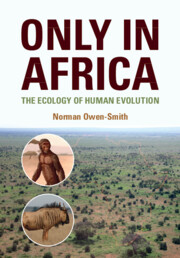Book contents
- Only in Africa
- Only in Africa
- Copyright page
- Dedication
- Contents
- Foreword
- Preface
- Abbreviations
- Part I The Physical Cradle: Land Forms, Geology, Climate, Hydrology and Soils
- Part II The Savanna Garden: Grassy Vegetation and Plant Dynamics
- Chapter 6 Forms of Savanna: From Woodland to Grassland
- Chapter 7 How Trees and Grasses Grow and Compete
- Chapter 8 Plant Demography and Dynamics: Fire Traps
- Chapter 9 Paleo-savannas: Expanding Grasslands
- Part II Synthesis: Savanna Structure and Dynamics
- Part III The Big Mammal Menagerie: Herbivores, Carnivores and Their Ecosystem Impacts
- Part IV Evolutionary Transitions: From Primate Ancestors to Modern Humans
- Appendix Scientific Names of Extant Animal and Plant Species Mentioned in the Book Chapters (Ecologically Conservative with Regard to Species Recognition)
- Index
- References
Chapter 9 - Paleo-savannas: Expanding Grasslands
from Part II - The Savanna Garden: Grassy Vegetation and Plant Dynamics
Published online by Cambridge University Press: 09 September 2021
- Only in Africa
- Only in Africa
- Copyright page
- Dedication
- Contents
- Foreword
- Preface
- Abbreviations
- Part I The Physical Cradle: Land Forms, Geology, Climate, Hydrology and Soils
- Part II The Savanna Garden: Grassy Vegetation and Plant Dynamics
- Chapter 6 Forms of Savanna: From Woodland to Grassland
- Chapter 7 How Trees and Grasses Grow and Compete
- Chapter 8 Plant Demography and Dynamics: Fire Traps
- Chapter 9 Paleo-savannas: Expanding Grasslands
- Part II Synthesis: Savanna Structure and Dynamics
- Part III The Big Mammal Menagerie: Herbivores, Carnivores and Their Ecosystem Impacts
- Part IV Evolutionary Transitions: From Primate Ancestors to Modern Humans
- Appendix Scientific Names of Extant Animal and Plant Species Mentioned in the Book Chapters (Ecologically Conservative with Regard to Species Recognition)
- Index
- References
Summary
This chapter describes how savanna grasslands spread initially during the late Miocene when C4 grasses appeared and expanded further during subsequent periods when global temperatures decreased. C3 grasses were replaced later in South Africa than in eastern Africa. Local vegetation structure and composition fluctuated in response to orbitally controlled cycles in global temperatures and hence aridity. Vegetation transformations from forest to heathland or grassland were surprisingly rapid. Grassland–forest mosaics were more prominently shown in fossil pollen than they are today.
- Type
- Chapter
- Information
- Only in AfricaThe Ecology of Human Evolution, pp. 128 - 137Publisher: Cambridge University PressPrint publication year: 2021

